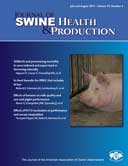Abstract:

Stillbirth and preweaning mortality in litters of sows induced to farrow with supervision compared to litters of naturally farrowing sows with minimal supervision
K. Nguyen, MSc; G. Cassar, DVM, PhD; R. M. Friendship, DVM, MSc, Diplomate ABPV; C. Dewey, DVM, MSc, PhD; A. Farzan, DVM, MSc, PhD; R. N. Kirkwood, DVM, PhD, Diplomate ECAR
Complete article is available online.
PDF version is available online.
Objective: To evaluate the benefits of induced farrowing with supervision on rates of stillbirths and preweaning mortality.
Materials and methods: A total of 159 multiparous sows were assigned in approximately equal numbers to two groups. Group One sows (n = 75) were induced to farrow using two intravulvar injections of 5 mg prostaglandin F2α administered 6 hours apart on day 114 of gestation (Day 0). Farrowing was supervised, with assistance given as required. Group Two sows (n = 84) were allowed to farrow naturally, with supervision and neonatal care standard for the production facility. All live piglets were weighed at 3 days and 21 days of lactation.
Results: Of the Group One sows, 56 farrowed during working hours on Day 1. There were fewer stillbirths per litter in Group One than in Group Two sows (0.4 ± 0.09 versus 1.0 ± 0.17, respectively). There was no effect of treatment on overall preweaning mortality. Weights were greater for Group One than for Group Two piglets at both 3 days of age (1.9 ± 0.04 kg versus 1.7 ± 0.02 kg, respectively; P < .01) and 21 days of age (5.7 ± 0.06 kg versus 5.5 ± 0.05 kg, respectively; P < .01).
Implications: Inducing farrowing and providing supervision on the day of farrowing can reduce stillbirths. However, reducing overall preweaning mortality requires more than 1 day of supervision.
Keywords: farrowing supervision, piglets, stillbirths, preweaning mortality
![]() Cite as: Nguyen K, Cassar G, Friendship RM, et al. Stillbirth and preweaning mortality in litters of sows induced to farrow with supervision compared to litters of naturally farrowing sows with minimal supervision. J Swine Health Prod 2011;19(4):214-217.
Cite as: Nguyen K, Cassar G, Friendship RM, et al. Stillbirth and preweaning mortality in litters of sows induced to farrow with supervision compared to litters of naturally farrowing sows with minimal supervision. J Swine Health Prod 2011;19(4):214-217.
Search the AASV web site for pages with similar keywords.
